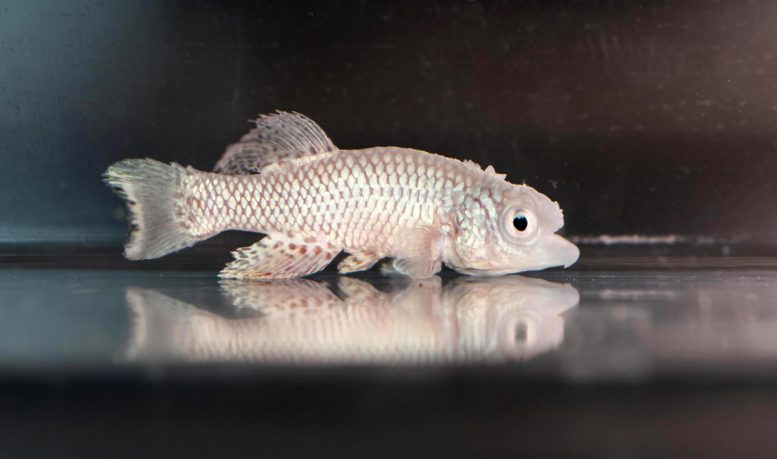A Max Planck Institute study on killifish revealed that older fish are stuck in a fasted state due to changes in adipose tissue. Activation of a specific subunit of the enzyme AMP kinase restored their health and longevity, suggesting new ways to promote healthier aging in humans.
Genetic switch saves aging fish from the trap of constant fasting
Fasting interventions, which involve alternating periods of fasting and refeeding, are generally thought to improve health. But these interventions do not work well in older animals.
The question is: why?
By studying short-lived killifish, researchers at the Max Planck Institute for the Biology of Aging in Cologne have shown that older fish deviate from their youthful fasting and refeeding cycle, and instead enter a state of permanent fasting, even when eating. However, the benefits of post-fasting refeeding can be restored in aged killifish by genetic activation of a specific subunit of AMP kinase, an important cellular energy sensor.
These mutant fish experienced improved health and longevity, suggesting that fasting and refeeding are necessary to confer health benefits and work through AMP kinase to do so.

Killfish's life is in fast motion. The bright colors of their youth fade after only a few months. Credit: K. Link/Max Planck Institute for the Biology of Aging
It has already been shown in several model organisms that a low-calorie diet, whether through caloric restriction or periods of fasting, has a positive effect on health. However, it is difficult for a person to eat smaller amounts of food throughout his life. In order to find the most appropriate timing for fasting, researchers introduced fasting interventions at different ages, and found that these interventions at older ages do not yield the same benefits as they do in younger animals.
A team of researchers from Cologne, Germany, investigated the age-related effects of fasting in killifish. Killifish are fast-aging fish and go from young to old in just a few months. The researchers either fasted small and large fish for a few days or fed them twice a day. They found that the visceral adipose tissue of older fish became less responsive to feeding. “Adipose tissue is known to react strongly to changes in food intake and has an important role in metabolism. That's why we looked at it more closely,” explains Roberto Riba, lead author of the study.
Alternating between fasting and eating is crucial
The researchers found that the inability to respond to the feeding phase puts the adipose tissue of old fish in a permanent state of fasting: energy metabolism is shut down, protein production is reduced, and tissues do not regenerate. We hypothesized that old fish would not be able to switch to fasting after feeding. “Surprisingly, the opposite was true, as the elderly fish were in a constant state of fasting, even while eating,” says Adam Antebi, director of the Max Planck Institute for the Biology of Aging and leader of the study.
Adipose tissue is in a permanent state of fasting
When the researchers looked more closely at how the fatty tissue of older fish differed from that of young fish, they found a specific protein called AMP kinase. This kinase is a cellular energy sensor and is composed of different subunits, the activity of the γ1 subunit decreases with age. When scientists increased the activity of this subunit through genetic modification, the fasting state was resisted and the old fish became healthier and lived longer.
Human aging
Interestingly, a link has also been found between the γ1 subunit and human aging. Much lower levels of the particular subunit were measured in samples from elderly patients. In addition, it would have appeared in human samples: the less frail a person is in old age, the higher the level of the γ1 subunit.
“Of course, we do not yet know whether the γ1 subunit in humans is actually responsible for healthy aging. “In the next step, we will try to find molecules that specifically activate this subunit and check whether we can use it to influence Positive effect on aging.
Reference: “AMPK associated with refeeding.”γ1 “Complex activity is the hallmark of health and longevity” by Roberto Ripa, Eugene Balhisa, Joachim D. Steiner, Raymond Laboy, Andrea Anibale, Nadine Houchard, Christian Lazza, Luca Dolfi, Chiara Calabrese, Anna M. Mayer, Maria Cristina Polidori, Roman-Ulrich Müller and Adam Antebi, November 13, 2023, Aging nature.
doi: 10.1038/s43587-023-00521-y

“Typical beer advocate. Future teen idol. Unapologetic tv practitioner. Music trailblazer.”






More Stories
‘It gave me goosebumps’: The most powerful gamma-ray burst ever observed was hiding a secret, scientists say
NASA’s Perseverance rover has found a rock on Mars that may indicate ancient life.
Northern Lights May Shine in Some States Tonight